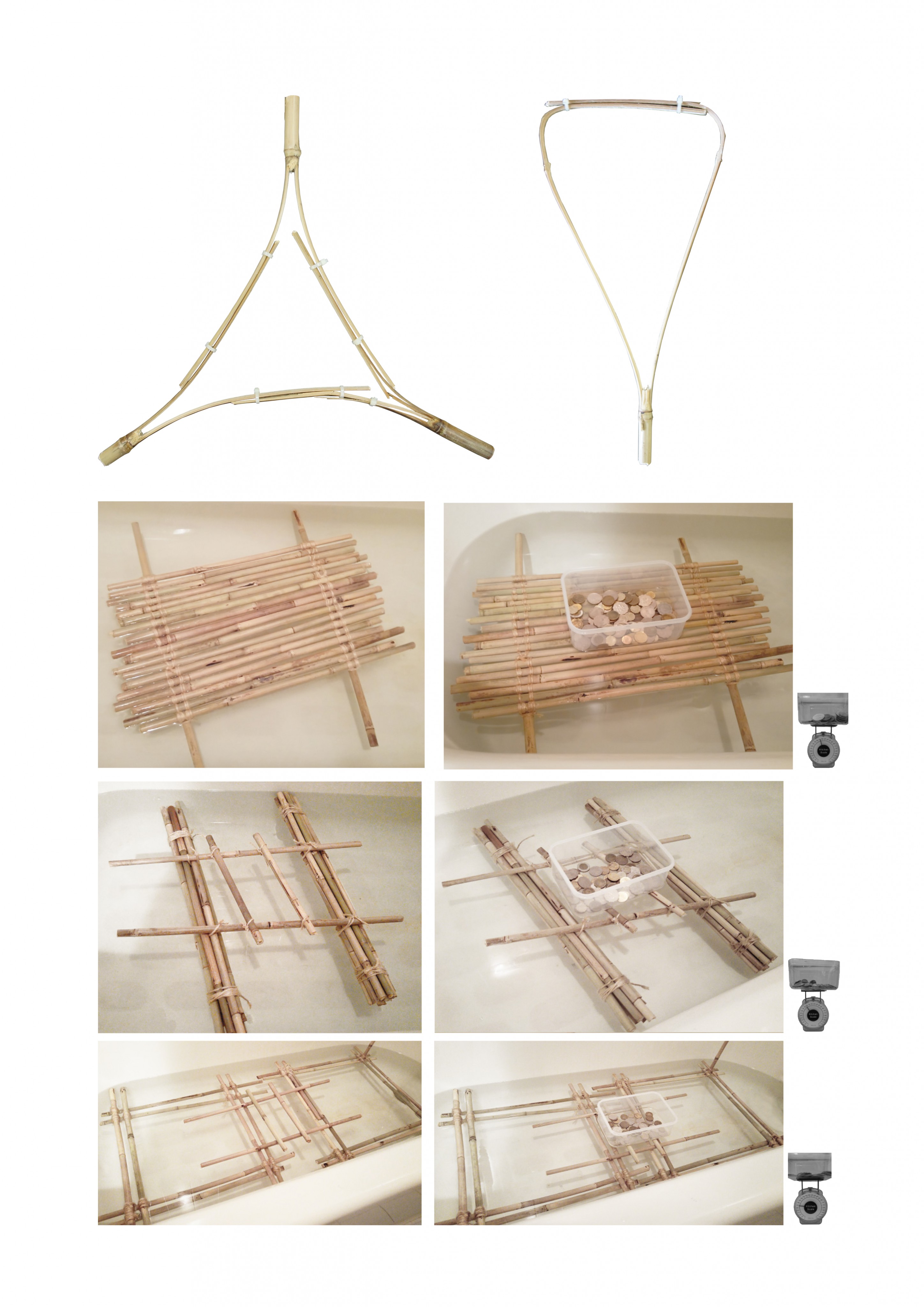|
 Bamboo Experiment of buoyancy and spatial structure, Maggie Hui Bamboo Experiment of buoyancy and spatial structure, Maggie Hui
This thesis investigates the structural properties of bamboo in order to achieve floating, easy assemble and continuity from foundation to spatial structure above to accommodate with inhabitable use and cultural program in different scale without occupying precious land.
WHY?

Precedent
In Semper’s theory, materials should appear responsive to the making process and expressive of its purpose. The traditional application retained traces of the practical use according to its structural property and convenience. Bamboo scaffolding framework with lashing connection for construction makes use of the lightweight and easily assembly characteristic; bundles of bamboo for the bridge with weaving pavement on top make use of the buoyancy; Bamboo raft further contains a bamboo shelter on top of the floating foundation as a separate structural installation to maximize flexibility and easy maintenance.
Contemporary
Semper described that weaving among 3 other essential categories which are moulding, carpentry and masonry aims at producing textiles and patterns. However, contemporary architecture not only celebrates and exposes bamboo for the spatial and material qualities but also pretends as the structural element. In the works by Markus Heinsdorff, Kengo Kuma and Vo Trong Nghia, permanent steel structure is embedded inside various form of bamboo including straight, split, bended or bundles of bamboo as a hidden primary structure or reinforcement. The texture, colour, enclosed spatial experience of bamboo are the main design focus. The material is mis-used.
My Proposition
This thesis tries to celebrates and widens the mis-use of materiality by putting bamboo architecture on the water. Firstly, for both aesthetic reason and floating properties of bamboo, bamboo architecture is always located adjacent to the waterbody or on the water. Due to the fact that full culm of bamboo provides better buoyancy, the transformation from a complete culm as foundation to different format of bamboo like spliting, weaving or bending as a new mis-used structure above can form a new spatial experience for different scale of program.
WHAT?
This thesis will design different portable floating bamboo modules which include structure on top integrating with the foundation. Different small units can be connected together for a larger events like a floating island or scattered pieces for semi-private use.
The site, scale and scope
This thesis takes waterbody as the test ground for the floating bamboo island with various scale of cultural program. One of the potential site is Kwun Tong Typhoon Shelter in Kai Tak new development area, which has Curise Terminal as a breakwater.
Why is this site (Hong Kong)?
1. Material Availablity
Since bamboo scaffoldling is widely used in the typical construction works in Hong Kong, the supply of bamboo is available and stable in Hong Kong.
2. Land shortage
Instead of land reclamination, the floating bamboo island is a sustainable, environmental friendly and cheaper way to obtain more floor area.
3. Humid climate
The weather condition including humidity, temperatures, precipitation fulfill the ideal growing conditions of bamboo. It is possible to promote bamboo planting in Hong Kong. The high humidity also prevents the bamboo from cracking.
Why is cultural program?
In the existing city fabric, there are various traditional events, performance and exhibition space along the coastal line in Hong Kong including HK Cultural Centre in TST, West Kowloon Cultural District, HK Convention and Exhibition Centre in Wan Chai, Victoria Park in Causeway Bay and Kwun Tong Promenade. The proposed site in Kai Tak New Development area with the curise terminal is one of the gateway of Hong Kong connecting different cultural spots to strenghthen the local cultural identity.
HOW?

This thesis examines the mis-use of bamboo by understanding the bamboo properties through series of experiments through 1:5 models (and/or 1:1) and 1:50 for prototype study. It aims at inventing a transformation from foundation on water to spatial structure above.
Review 1.0 – Technical Research & Model Testing (Due 4th Feb)
To compare existing buoyant bamboo structure and joineries in different composition, explore the transformation structure through experiment on splitting, bending and weaving bamboo and preliminary research of the site.
Review 2.0 – Operation System & Master Planning (Due 14th Mar)
To explore how bamboo structure can be attached and detached, different methodology to extend it’s biologicial degradation and program zoning on the site.
Review 3.0 – Revision / Refinement (Due 3rd May)
To deeply study various composition of bamboo structure for different scale of program, interaction with water and prepration works for final presentation including Final Models, Drawings, Renderings.
Final Review – Final development / Touch up (Due 7th Jun)
Bibliography
Theory:
1. Frampton, Kenneth. Towards a Critical Regionalism: Six Points for an Architecture of Resistance. , in “Anti-Aesthetic. Essays on Postmodern Culture.” Seattle: Bay Press 1983.
2.Semper, Gottfried. The Four Elements of Architecture and Other Writings. Trans. Harry F. Mallgrave and Wolfgang Herrmann Cambridge, 1989.
Techniques:
1. Gass, Siegfried, Heide Drüsedau, Jürgen Hennicke, and Klaus Dunkelberg. Bambus =: Bamboo. Stuttgart: Institut für Leichte Flächentragwerke, Universität Stuttgart, 1985.
Projects:
1. Vegesack, Alexander , and Mateo Kries. Grow Your Own House: Simón Vélez Und Die Bambusarchitektur = Simón Vélez and Bamboo Architecture. Weil am Rhein, Germany: Vitra Design Museum, 2000.
2. S.H. Lau, Freeman. Rethinking Bamboo: Aspects of Contemporary Bamboo Design. Hong Kong: Asia One Books 2013.
|